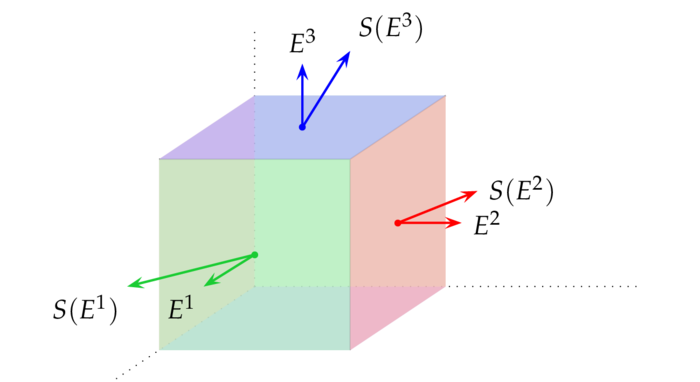Classical Examples
Classical stress tensor field
Suppose $M\sbe\R^3$ is some elastic material. For a point $m\in M$ we consider a normalized vector $N$ in the tangent space $T_mM$ of $M$ and a small surface $A$ normal to $N$. Internal strains of the material exert a force $F$ on $A$, which for small surfaces is proportional to the area $|A|$ of $A$. In general the force $F$ and the normal $N$ are not col-linear. Let`s assume the limit $$ S(N)\colon=\lim_{|A|\to0}\frac{F}{|A|} $$ exists at every point $m\in M$. Hence the force exerted at a surface $A$ with unit normal $N$ is up to first order given by $S(N)|A|$. For $\l\geq0$ we put $S(\l N)=\l S(N)$. This way we obtain a mapping $S_m:T_mM\rar T_mM$ and for normed $N$ $S(N)$ is just the force exerted on a unit surface normal to $N$. We`d like to justify why $S$ should be linear: At equilibrium no part of the material moves at all and hence the force exerted at a surface element $A$ with unit normal $N$ and the force exerted at a surface element $A$ with unit normal $-N$ must vanish, i.e. $S(-X)=-S(X)$. Moreover, for a normalized vector $N\in T_mM$ we consider a small tetrahedral block of material with faces $A_1,A_2,A_3$ and $A$ normal to an orthonormal basis $-E^1,-E^2,-E^3$ and $N=n_1E^1+n_2E^2+n_3E^3$ for some $n_j > 0$. Again at equilibrium the sum of the forces on the faces must vanish and thus $$ S(N)|A|+S(-E^1)|A_1|+S(-E^2)|A_2|+S(-E^3)|A_3|=0~. $$ Since $|A_j|=|A|\la N,E^j\ra$, we have $|A_j|/|A|=n_j$ and therefore $$ S(N)=n_1S(E^1)+n_2S(E^2)+n_3S(E^3)~. $$ Hence $S$ must be linear.
Beware! text books in theoretical physics usually drop the term 'field' for any sort of tensor field: thus the 'stress tensor field' is simply called 'stress tensor'!
Perfect fluid
Let $M\sbe\R^3$ be a fluid and again $m\in M$ an arbitrary but fixed point. Let $V$ be the velocity of the fluid at $m$, $\r(m)$ the density of the fluid at $m$ and $P(m)$ the pressure at $m$. We define a bi-linear map $T:T_mM\times T_mM\rar\R$: $$ T(X,Y) \colon=\r(m)\la X,V\ra\la Y,V\ra+P(m)\la X,Y\ra =\la\r(m)\la X,V\ra V+P(m)X,Y\ra $$ Assuming $T$ to be a stress tensor field we get for the associated force $S(X)$ on a unit surface normal to a unit vector $X\in T_mM$: $$ S(X)=\r(m)\la X,V\ra V+P(m)X~. $$ Thus for $X\perp V$ the force is isotropic and its norm is $P$; for $X=V/\norm V$ the force acts again in the direction of $X$ but its norm is $\r\norm V^2+P$, accounting for the additional pressure of the flow.Symmetry
Any inner product is symmetric. Also the stress tensor field of a perfect fluid is symmetric, indeed $$ T(Y,X)= \r(m)\la Y,V\ra\la X,V\ra+P(m)\la Y,X\ra =\r(m)\la X,V\ra\la Y,V\ra+P(m)\la X,Y\ra =T(X,Y)~. $$ Actually, any stress tensor should be symmetric. To show this satisfactorily we consider the moment $N$ on a small cubic block at about $m\in M$. Up to a constant factor this moment is the sum of the moments of all six faces of the cubic block; as $S$ is linear we have $S(-E^j)=-S(E^j)$ and therefore: $$ N=2\sum_{j=1}^3 E^j\times S(E^j)~. $$ At equilibrium this moment must vanish. By vector calculus we also have: $$ \la E^j\times S(E^j),X\ra =\la X\times E^j,S(E^j)\ra $$ and thus we get for e.g. $X=E^1$: \begin{eqnarray*} 0&=&\la E^1\times E^2,S(E^2)\ra+\la E^1\times E^3,S(E^3)\ra\\ &=&\la E^3,S(E^2)\ra-\la E^2,S(E^3)\ra =T(E^2,E^3)-T(E^3,E^2) \end{eqnarray*}
Relativistic perfect fluid
In the relativistic case we replace the Euclidean product with the Lorentz product and the velocity with an instantaneous observer $U$. Finally instead of the mass density $\r$ we take the energy density observed by $U$, which we will also denote by $\r$. Now we stipulate the following properties:- If $X,Y$ are in the local rest space of the instantaneous observer $U$, i.e. $X,Y\perp U$, then $T(X,Y)$ should be the force exerted on a unit surface normal to $X$ in the direction of $Y$, i.e.: $T(X,Y)=P\la X,Y\ra$.
- If $X=U$, then $T(X,X)$ should be the energy density $\r$ observed by $U$, i.e. $T(U,U)=\r$.